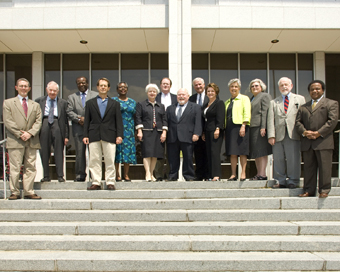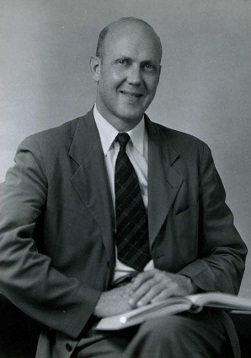Historical Commission
 In 1903, at the behest of the North Carolina Literary and Historical Association, the General Assembly established the North Carolina Historical Commission to collect and print "from the files of old newspapers, from court records, church records and elsewhere valuable documents pertaining to the history of the State." Its gubernatorially appointed members served without salary, and its initial annual appropriation was $500. William J. Peele was the commission's first chairman, and R. D. W. Connor served as secretary. During its first four years, the commission's chief accomplishment was publishing Literary and Historical Activities in North Carolina, 1900-1905. In 1907 the legislature expanded the commission's authority, and with a tenfold increase in appropriated funds, the commission engaged Connor as its first paid secretary. From that date North Carolina retained a true state archival agency, successfully guided by Connor until 1921, when he resigned to become a history professor at the University of North Carolina at Chapel Hill.
In 1903, at the behest of the North Carolina Literary and Historical Association, the General Assembly established the North Carolina Historical Commission to collect and print "from the files of old newspapers, from court records, church records and elsewhere valuable documents pertaining to the history of the State." Its gubernatorially appointed members served without salary, and its initial annual appropriation was $500. William J. Peele was the commission's first chairman, and R. D. W. Connor served as secretary. During its first four years, the commission's chief accomplishment was publishing Literary and Historical Activities in North Carolina, 1900-1905. In 1907 the legislature expanded the commission's authority, and with a tenfold increase in appropriated funds, the commission engaged Connor as its first paid secretary. From that date North Carolina retained a true state archival agency, successfully guided by Connor until 1921, when he resigned to become a history professor at the University of North Carolina at Chapel Hill.
 During his tenure, Connor launched an aggressive campaign to acquire private manuscripts and to transfer county and state records to the State Archives. Oversight of the Hall of History, a museum started by Frederick A. Olds, was transferred to the commission in 1914. The entire agency moved into the new State Administration Building (later known as the State Library Building and now the Court of Appeals Building), where it remained until moving to the first floor of the new Education Building in 1939. Meanwhile, from 1915 to 1933 the commission also administered the Legislative Reference Library.
During his tenure, Connor launched an aggressive campaign to acquire private manuscripts and to transfer county and state records to the State Archives. Oversight of the Hall of History, a museum started by Frederick A. Olds, was transferred to the commission in 1914. The entire agency moved into the new State Administration Building (later known as the State Library Building and now the Court of Appeals Building), where it remained until moving to the first floor of the new Education Building in 1939. Meanwhile, from 1915 to 1933 the commission also administered the Legislative Reference Library.
Following Connor's departure, secretaries D. H. Hill (1921-24), Robert B. House (1924-26), Albert Ray Newsome (1926-35), and C. Christopher Crittenden (1935-68) carried on the various programs of the Historical Commission. The distinguished series of documentary publications continued, the quarterly North Carolina Historical Review began in 1924, and public records legislation in 1935 gave the commission authority over the disposal of all public records: local, county, and state. During the Depression the commission administered several federal relief projects that inventoried and publicized the state's historical resources, most notably the county records. During both world wars it collected war-related records for future research, and, after 1935 the commission erected highway historical markers throughout the state. Its record has been summarized in The North Carolina Historical Commission: Forty Years of Public Service, 1903-1943 (1943).
The name of the agency changed in 1943 to the State Department of Archives and History, and two years later the name of the seven-member commission changed to Executive Board and the secretary became the director. After the Department of Archives and History became a division of the new Department of Art, Culture, and History (later renamed the Department of Cultural Resources), however, the name North Carolina Historical Commission was revived in 1973 and applied to a professional body with broad policymaking powers over the Office of Archives and History.
References:
Frontis W. Johnston, "The North Carolina Historical Commission, 1903-1978," in Jeffrey J. Crow, ed., Public History in North Carolina, 1903-1978 (1979).
Ansley Herring Wegner, History for All the People: One Hundred Years of Public History in North Carolina (2003).
Additional Resources:
North Carolina Historical Commission: forty years of public service, 1903-1943. https://digital.ncdcr.gov/Documents/Detail/north-carolina-historical-commission-forty-years-of-public-service-1903-1943/2148997
North Carolina Historical Commission. Biennial report of the North Carolina Historical Commission. 1903-1978. Raleigh: Edwards & Broughton. 1904-1942. https://digital.ncdcr.gov/Documents/Detail/biennial-report-of-the-north-carolina-state-department-of-archives-and-history/1951811
"North Carolina Historical Commission." 2009. North Carolina Office of Archives and History. http://www.history.ncdcr.gov/nc-hist-com.htm
Connor, R.D.W. The North Carolina Historical Commission: Creation and Organization, Duties and Powers, Plans and Purposes. North Carolina Historical Commission. 1907. http://books.google.com/books?id=XLMTAAAAYAAJ&pg=PA1#v=onepage&q&f=false
Image Credits:
Westmoreland, Alan. "The North Carolina Historical Commission — 2009." Raleigh, N.C. August 2009. North Carolina Office of Archives and History. http://www.history.ncdcr.gov/nc-hist-com.htm
North Carolina State Dept. Of Archives and History. "PHOTOGRAPH Accession #: H.1953.54.1." 1952. From the North Carolina Museum of History.
1 January 2006 | Jones, H. G.